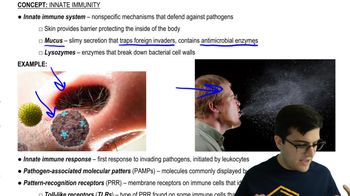Innate Immunity definitions Flashcards
 Back
BackTerms in this set (12)
Innate Immune System
The body's first line of defense against pathogens, providing a rapid, non-specific response through barriers, phagocytes, and signaling molecules to prevent infection and initiate inflammation.
Pathogens
Microorganisms or agents that cause disease in their host, including bacteria, viruses, fungi, and parasites.
Skin
The body's outermost layer, acting as a physical barrier to protect internal tissues from pathogens, while also playing a role in the innate immune response.
Mucus
A viscous secretion that traps pathogens at body openings, contains antimicrobial enzymes, and aids in their expulsion, providing a non-specific defense mechanism in the innate immune system.
Lysozymes
Enzymes that degrade bacterial cell walls, found in mucus and other body fluids, providing a nonspecific defense against pathogens.
Leukocytes
White blood cells that play a crucial role in the body's immune response by identifying and eliminating pathogens through various mechanisms, including phagocytosis and cytokine release.
Pathogen Associated Molecular Patterns
Molecules on pathogens recognized by the innate immune system, triggering a non-specific immune response.
Lipopolysaccharides
Molecules on bacterial cell surfaces that trigger the innate immune response by acting as pathogen-associated molecular patterns (PAMPs) recognized by pattern recognition receptors (PRRs).
Pattern Recognition Receptors
Membrane receptors on immune cells that detect pathogen-associated molecular patterns (PAMPs) to trigger an innate immune response.
Toll Like Receptors
Membrane receptors on immune cells that recognize pathogen-associated molecular patterns, triggering a signaling cascade to recruit other immune cells and initiate an immune response.
Neutrophils
Phagocytic white blood cells that circulate in the blood, attracted to infection sites by cytokines, engulf and digest pathogens, acting as mobile warriors in the innate immune system.
Macrophages
Immune cells that reside in tissues, engulf pathogens, and release signals to recruit other immune cells, playing a key role in both innate and adaptive immunity.



